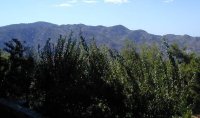
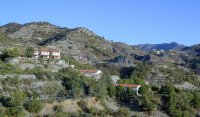
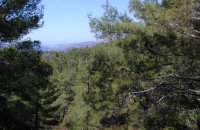

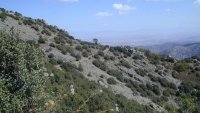
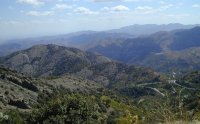

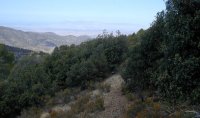
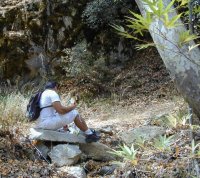
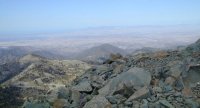

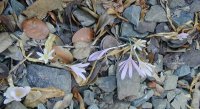
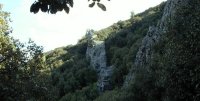
I visited Cyprus in September on a walking tour which started in the centre of the island in the pine-clad Troodos mountains, taking in the Caledonian Waterfall trail near Platres and then a long day’s route from the Trooditissa monastery to Foini, Omodos, Ayia Mauri and Lofou, crossing several sub-parallel ridges on the way. Then we transferred to the Akamas, the claw-shaped peninsula at the north-west tip of the island for more walking, from Drouseia to Neo Chorio and thence down to the coast near the “Baths of Aphrodite”.
Much of the walking, especially in the Troodos mountains and Akamas, was on well-maintained nature trails set up by the Cyprus Forestry Department, who keep them clear and provide signposts, information boards and small wooden posts with the names of plants (and rather tmore surprisingly, rock types) in Greek and English, with the international “Latin” binomial for the plants as well. The island has many interesting plants and animals – my lists are below.
I flew into Pafos (or Paphos depending on the transcription of the Greek phi!), and had a couple of days unwinding in a beach-side hotel, with the chance to swim in the remarkably warm sea.
[Click on the thumbnails for a bigger picture.]
| Pouziari map. One of the information boards provided by the Forestry service: sadly these maps were rather hard to follow! | 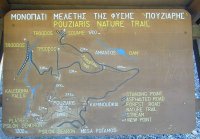 |
| Pouziari view. Two views taken on the Pouziari trail as it climbs up into the pine forest. | 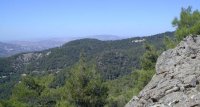 |
| Pouziari view. | 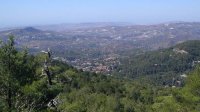 |
| Mountain campion. Near the top (probably at c.1500m) I spotted this delightful mountain campion (probably a Silene sp.) growing in the rocks. |  |
| Mountain campion close-up. | 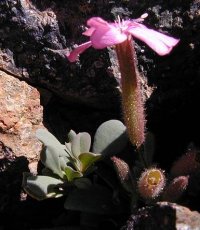 |
| Pouziari – black pine. This is a fine specimen of the mountain or black pine Pinus nigra. Sometimes they develop flat tops when the growing point is broken by the weight of winter snow – rather surprisingly up to 3m (10ft) of snow can fall up here! | 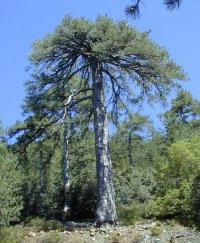 |
| Arbutus andrachne. The Cyprus strawberry-tree, with peeling bark to reveal the characteristic red trunks. | 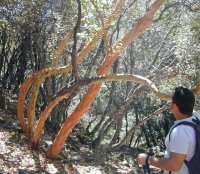 |
| Caledonia Trail. Coming down we joined the Caledonia trail, following the Kryos Potamos (Cold River) down its gorge; this stream is unusual in that it runs all year round, so its valley is very lush and green. There are little trout in the pools. |  |
| Caledonia Waterfall. The waterfall is very attractive. Apparently it was named after “Caledonia” by an early British ex-pat as it reminded him of Scotland! | 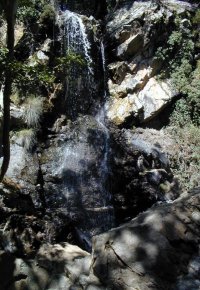 |
| Wehrlite sign. Not only the plants have information signs, so do the rocks... | |
| Cardinal butterfly on leaf. This was the best photo I could manage of a butterfly that had the most glorious orange-red upper side. The id is by Guy Padfield – thanks Guy. | 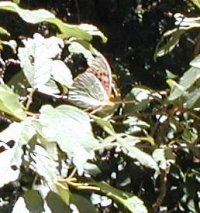 |
| Argynnis Pandora Cardinal butterfly. This is a much better picture of the Cardinal, taken by Guy, which shows the orange on the upper wing, though not the even brighter colours on the upperside. [photo © Guy Padfield, used with permission.] |
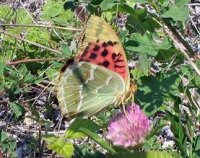 |
| Pafos – view of sea. View from the hotel balcony with palm trees on the beach (there were bananas too). |  |
Many of these were only seen as leaves, or seedheads.
| Acer obtusifolium | maple (but with hardly-lobed leaves) |
| Alnus orientalis | alder (asiatic) |
| Alyssum troodi | Troodos alyssum (endemic) |
| Arabis purpurea | purple arabis (endemic) |
| Arbutus andrachne | Cyprus strawberry tree (usually a bush, v. common) |
| Asphodelus sp. | asphodel (bulbs) |
| Berberis cretica | barberry |
| Capparis spinosa | caper |
| Carlina spp. | carline thistles, some very large |
| Cedrus libani var. brevifolia | Cyprus cedar (a distinct endemic variety of the cedar of Lebanon) |
| Centaurea hyalolepis | golden star thistle, very common |
| Cistus | sunrose [5spp. C. creticus (pink), C. salvifolius (white), C. parvifolius, C. ladanifer and C. monspeliensis] |
| Colchicum troodi | autumn colchicum, locally common |
| Crataegus azarolus | yellow-berried hawthorn |
| Crataegus monogyna | common (red-berried) hawthorn |
| Cupressus sempervirens | cypress |
| Dianthus sp. | pinks |
| Ecballium elaterium | exploding cucumber |
| Echinops spinosissimus | giant globe thistle |
| Foeniculum vulgare | fennel |
| Genista fasselata | genista (“broom”) |
| Genista sphacelata | spiny gorse |
| Helichrysum siculum | curry plant |
| Juniperus spp. | juniper [several spp., incl. J. oxycedrus, J. phoenicea, J. foetidissima, J. excelsa] |
| Laurus nobilis | bay |
| Lonicera etrusca | honeysuckle |
| Mentha longifolia ssp. cyprica | mint (grows in damp spots) |
| Myrtus communis | myrtle |
| Nerium oleander | oleander |
| Origanum spp. | oregano, incl. O.majorana var. tenuifolium (endemic) |
| Paeonia mascula ssp. mascula | wild peony |
| Pinus brutia | Calabrian or common pine |
| Pinus halepensis | Aleppo pine (introduced) |
| Pinus nigra | black or mountain pine (mostly subsp. pallasiana, some subsp. caramanica) |
| Pistachia lentiscus | mastic tree |
| Pistachia terebinthus | terebinth or turpentine tree |
| Platanus orientalis | eastern plane |
| Populus nigra var. afghanica | black poplar |
| Rosa canina | dog rose |
| Rosa chionistrae | endemic rose |
| Rhus coriaria | sumach |
| Rubus sancta | Cyprus bramble |
| Salix sp. | willow (possibly S. alba) |
| Salvia | sage [several spp. including S. willeana and S. fruticosa] |
| Silene sp. | campion (possibly S.cyprica) |
| Smilax aspera | smilax vine |
| Sorbus aria ssp. cretica | Whitebeam |
| Styrax officinalis | storax |
| Taraxacum sp. | dandelion (leaves in spring, “naked” flowers autumn) |
| Thymus capitatus | thyme |
| Quercus alnifolius | endemic “golden oak” |
| Quercus brevifolius (?) | evergreen oak (can’t find this in the reference book!) |
| Quercus infectoria ssp. veneris | “royal oak” |
| Quercus coccifera | “evergreen oak” |
| Urginea maritima | sea squill (locally common, grows from a large bulb) |
| Vicia sp. | vetch |
| Viola siehiana | violet (leaves only) |
In autumn when I was there there were relatively few plants in flower, but there were seedheads, some of them quite ornamental such as the giant carline thistles. The fruits of the exploding cucumber were extraordinary – about the shape and size of gherkins, if they are touched when ripe they do indeed explode – you can hear the seeds landing all around you several feet from the plant!
Many of the plants have (or had) medicinal or industrial uses, for example the wild peony was used for medicine, and the cistus species provided “ladanum” gum. The wood of the arbutus is very hard, and was used for (tobacco) pipes and making chairs.
Some, such as the bramble, yellow-berried hawthorn, thyme, oregano and caper, have culinary uses. Other plants are poisonous and to be avoided, for instance the colchicum.
Among the crops are peanuts, beans, various grains such as wheat, and orchards of apples, pomegranates, almonds, olives, carobs, walnuts,... and of course vineyards. We also saw pear and fig trees growing along the roadside.
Dabchick
Little Egret (?)
Marsh Harrier (f)
Buzzard (?)
Kestrel (f)
Eleanora’s Falcon
Chukar partridge
Coot (? – but grey wings and dark brown neck)
Collared Dove
Domestic Pigeon
Little Owl (? – could possibly have been Scops Owl)
Nightjar (? – seen hawking at dusk)
Swift (at first I thought it was Pallid Swift as definitely brown; young?)
Bee-eater – very common
Hoopoe – my guide saw one which I missed...
Crested Lark
Swallow
Red-rumped swallow
House Martin
Wren (heard, not seen)
Cyprus Pied Wheatear
Cyprus Warbler
Whitethroat (family party)
Leaf Warbler, probably willow warbler (pale yellow-green, brown legs)
Coal tit
Great tit
Lesser Grey Shrike (?)
Jay
Magpie
Jackdaw
Hoodie
Raven
House Sparrow
Chaffinch
Serin
Greenfinch (f or young)
Goldfinch
Linnet
Crossbill (not seen, but fircones eaten)
The butterfly seen in the Caledonia gorge is a cardinal, Argynnis pandora (Pandoriana pandora in many books). I also saw many meadow brown-type butteflies, and one small blue one.
Text and Pictures by Gill Smith © Copyright 2005